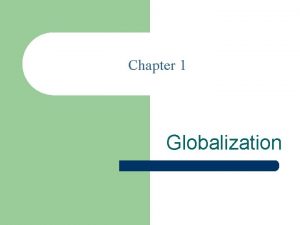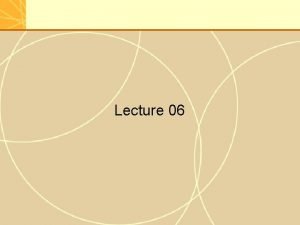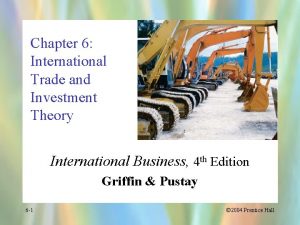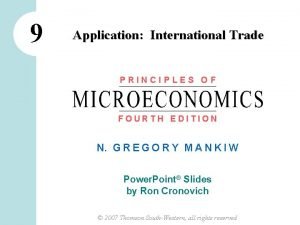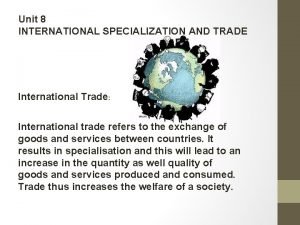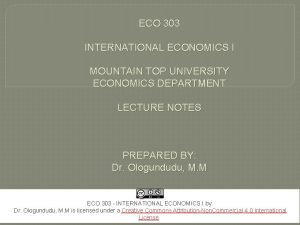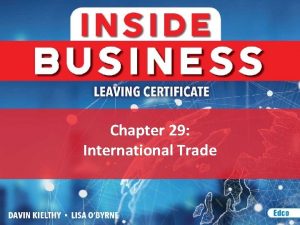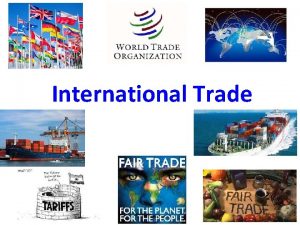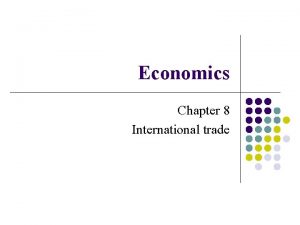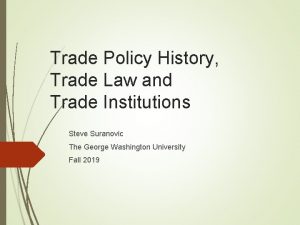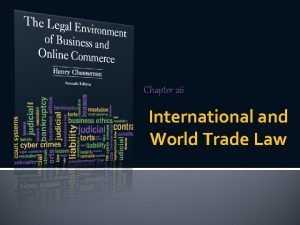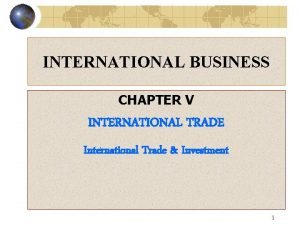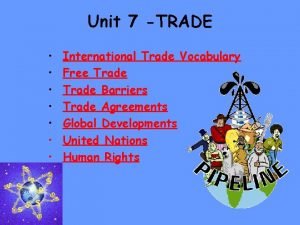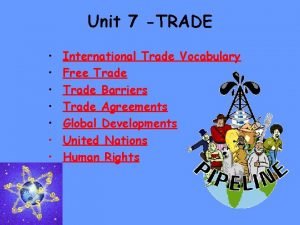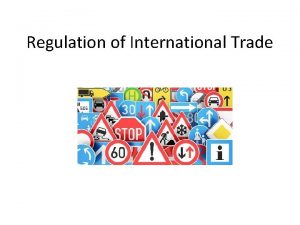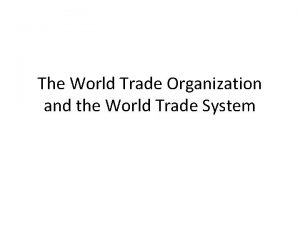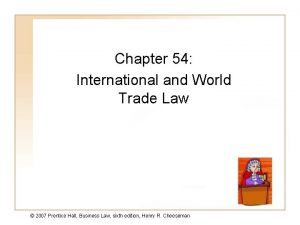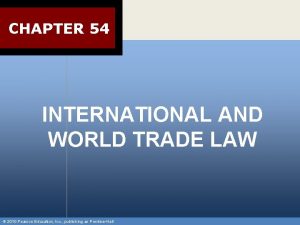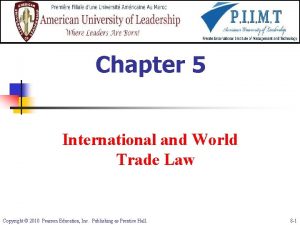Chapter 8 International and World Trade Law International



















- Slides: 19

Chapter 8 International and World Trade Law

International Law n International law is law that governs affairs between nations and that regulates transactions between individuals and businesses of different countries. 8 -2

Features of International Law n n n No single legislative source No single world court to interpret No world executive branch to enforce 8 -3

United States and Foreign Affairs n Foreign Commerce Clause n n Vests Congress with the power “to regulate commerce with foreign nations” Treaty Clause n States that the President “shall have power, by and with the advice and consent of the Senate, to make treaties, provided two-thirds of the senators present concur” 8 -4

Sources of International Law n Treaties and conventions n n Agreements or contracts between two or more nations that are formally signed by an authorized representative and ratified by the supreme power of each nation Custom n Consistent, recurring practices between two or more nations over a period of time that have become recognized as binding 8 -5

Sources of International Law n General principles of law n n Principles of law recognized by civilized persons Judicial decisions and teachings n Judicial decisions and writings of the most qualified legal scholars of the various nations involved in a dispute 8 -6

United Nations n An international organization created by a multilateral treaty in 1945 8 -7

U. N. Structure n Governed by: n The General Assembly n n The Security Council n n Composed of 15 member nations The Secretariat n n Composed of all member nations Administers day-to-day operations The World Court n Judicial branch of the U. N. 8 -8

U. N. Agencies n n International Monetary Fund (IMF) World Bank n n Financed by developed countries Provides funding to developing countries for projects and humanitarian aid 8 -9

Regional International Organizations n European Union n Opens borders for trade among member nations Eliminates customs duties among member nations North American Free Trade Agreement (NAFTA) n Removes or reduces trade barriers between U. S. , Mexico, and Canada 8 -10

Regional International Organizations n n Association of Southeast Asian Nations (ASEAN) Central America Free Trade Agreement (CAFTA) Dominican Republic-Central America Free Trade Agreement (DR-CAFTA) Free Trade Area of the Americas (FTAA) 8 -11

World Trade Organization (WTO) n n Created by General Agreement of Tariffs and Trade (GATT) WTO dispute resolution n n Adopted a “judicial” mode 3 -member panel hears a dispute and issues a panel report. Report is referred to the dispute settlement body of the WTO. An appellate body hears appeals. WTO can order sanctions for noncompliance. 8 -12

National Courts n n Most international trade disputes are heard by national courts of individual nations. Jurisdiction may be determined by terms of the contract between parties. 8 -13

Jurisdiction n Forum selection n n Designates the judicial or arbitral forum that will hear and decide the case Choice of law n Designates the law to be applied by the court or arbitrator in deciding the case 8 -14

Act of State Doctrine n Act of state doctrine n An act of a government in its own country is not subject to suit in another country’s courts. 8 -15

Sovereign Immunity Doctrine n Sovereign immunity n n Act of a government in a foreign country is not subject to suit in the foreign country. Foreign Sovereign Immunities Act (FSIA) of 1976 n A foreign country is not immune from suits in the U. S. if the suit is based on commercial activity in the U. S. or directly affecting the U. S. 8 -16

International Arbitration n n Nonjudicial method of dispute resolution where a neutral third party decides the case Parties agree to be bound by the arbitrator’s decision. 8 -17

International Law Based on Religious Codes n n n Jewish Law and the Torah Islamic Law and the Koran Hindu Law and Dharmasastra 8 -18

Copyright © 2010 Pearson Education, Inc. Publishing as Prentice Hall. 8 -19
 The changing world output and world trade picture
The changing world output and world trade picture The changing world output and world trade picture
The changing world output and world trade picture Newton's first law and second law and third law
Newton's first law and second law and third law Newton's first law
Newton's first law Chapter 6 theories of international trade and investment
Chapter 6 theories of international trade and investment Trade diversion and trade creation
Trade diversion and trade creation Trade diversion and trade creation
Trade diversion and trade creation Which is the most enduring free trade area in the world?
Which is the most enduring free trade area in the world? Trade diversion and trade creation
Trade diversion and trade creation Tramp trade software
Tramp trade software Chapter 9 application: international trade answers
Chapter 9 application: international trade answers Boyles law
Boyles law Charles law constant
Charles law constant The trade in the trade-to-gdp ratio
The trade in the trade-to-gdp ratio Fair trade not free trade
Fair trade not free trade Triangular trade
Triangular trade Ap world history chapter 25 africa and the atlantic world
Ap world history chapter 25 africa and the atlantic world Specialization in international trade
Specialization in international trade Certificate in international trade and finance citf
Certificate in international trade and finance citf Kravis theory of availability
Kravis theory of availability
